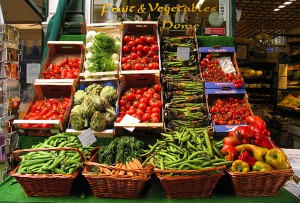Eating more fresh fruits and vegetables is one of the easiest ways to improve your health.
Unprocessed fruits and vegetables are full of vitamins, minerals, and antioxidants. Think of them as nature’s pharmacy—healthy living at a fraction of the cost of supplements.
A diet rich in fruits and vegetables can reduce your risk of many medical conditions, like heart disease and stroke, high blood pressure, and certain types of cancer. Fruits and vegetables can also keep your eyes working, and help you avoid two common diseases of the eye related to aging—cataracts and macular degeneration.
For the Fastest Change, Pick Your Battles Wisely
If you are trying to lose weight, or want to cut back on junk food, forget about those goals for now, and focus just on increasing your intake of fresh fruits and vegetables.
It’s not easy to change your habits. By focusing on one goal (or possibly two) at a time, you will be more likely to succeed. You are also more apt to notice the small changes happening in your life.
Even more importantly, eating more fresh fruits and vegetables will have a ripple effect on the rest of your life. You will feel better, both physically and mentally, which will make it easier to tackle your other healthy living goals.
What Does “More” Fresh Fruits and Vegetables Mean?
 If you are a typical American—who eats only three servings of fruits and vegetables a day—this means more than what you are eating now.
If you are a typical American—who eats only three servings of fruits and vegetables a day—this means more than what you are eating now.
The latest dietary guidelines from the U.S. Department of Agriculture recommends five to thirteen servings of fresh fruits and vegetables a day (around 2.5 to 6.5 cups a day), depending upon your calorie needs (which are based upon your sex, age, activity level, height, and weight).
An average person, then, will need around 4.5 cups per day (2 cups of fruit, and 2.5 cups of vegetables).
It’s almost impossible to eat too many fruits and vegetables, though, especially if you don’t smother them with fatty dressings or vegetable dips. If in doubt, eat more vegetables. You can also eat more fruit, but try not to overdo it, because fruit tends to be high in sugar.
Five Easy Ways to Eat More Fruits and Vegetables
Eating more fresh fruits and vegetables is a challenge for many people. For some, vegetables are “boring.” For others, it’s “easier” to eat junk food, especially when away from home.
Use these healthy living tips to keep yourself on track. It will take a few weeks to shift your habits, and you may need to recommit yourself to your goal every few months. Over time, though, eating fresh fruits and vegetables will seem natural.
- Set and track your goal. Decide how many servings of fresh fruits and vegetables you need to eat each day. Start slowly. If you want to reach nine servings a day, but are currently only eating two, aim for five in the beginning. Give yourself at least four weeks to develop your new healthy habit. Keep track of your progress by using a journal or mobile app. This will help you see how far you’ve come.
- Divide and conquer. If you are aiming for five servings of fruits and vegetables a day, spread them out over your meals and snacks—such as one serving for each meal, plus one serving for each of two snacks. When you break it down like this, the goal seems more manageable.
- Give vegetables a place at the table. When preparing your meals, start with a vegetable dish. Make it special. Try using herbs and spices, and use olive oil instead of other fatty dressings. When you sit down to eat, start with your vegetables. At the end of the meal, if you are still hungry, have a piece of fruit or some more vegetables.
- Put the fruits and vegetables before the junk food. Whenever you are craving a snack, eat a piece of fruit or a cup of chopped vegetables. Don’t worry, you can have your vegetables and eat your cake, too—as long as the cake comes last. You may even find that, after eating an apple, you aren’t as hungry for sugary desserts afterwards.
- Make time for preparation and presentation. Convenience is a big factor in snacking. It’s easier to grab a bag of chips than to clean and cut up a serving of carrots. Set aside some time during your week to chop vegetables and fruit, like bell peppers, carrots, or apples. You can do this the night before or at the start of your week. Keep the chopped fruits and vegetables within arm’s reach both at home and at work. You are more likely to eat them when you can see them and pick them up easily.
__________
Photo: Fruits and Vegetables: Turnham Green, © Copyright Pam Brophy and licensed for reuse under this Creative Commons License.


